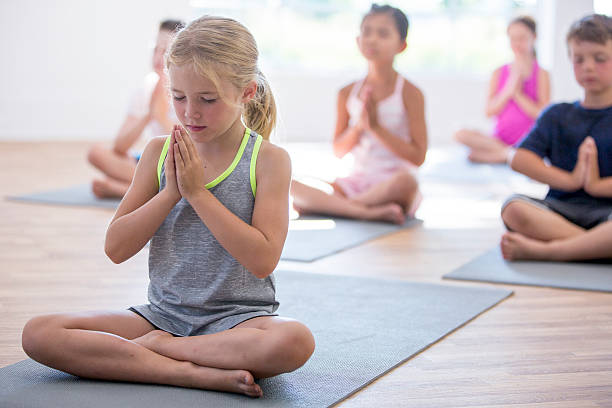In a world full of screens, schedules, and constant stimulation, helping children find moments of peace has never been more important. Meditation is a wonderful way to nurture calmness, emotional intelligence, and self-awareness in kids. However, teaching meditation to children requires a different approach than with adults — one that is engaging, imaginative, and age-appropriate. This article explores how to create a Kid-Friendly Meditation script that captures a child’s attention, teaches mindfulness, and fosters relaxation in a fun and accessible way.
Why Meditation Is Beneficial for Kids:
Before diving into how to write a script, it’s essential to understand why meditation matters for children. Studies show that mindfulness and guided meditation can help kids:
- Reduce stress and anxiety
- Improve focus and attention span
- Enhance emotional regulation
- Develop empathy and patience
- Sleep better and feel calmer
Children naturally have vivid imaginations, which makes them especially receptive to guided imagery and storytelling-based meditation.
Key Elements of a Kid-Friendly Meditation Script:
When writing a meditation script for children, simplicity and creativity are key. Below are essential elements to include:
Start with Gentle Grounding:
Begin by helping children settle their bodies and minds. Encourage them to sit or lie down comfortably and take a few deep breaths.
Use Imagination and Storytelling:
Kids connect best through stories. Turn your meditation into a simple journey — a walk through a magical forest, floating on a cloud, or visiting a peaceful garden.
This keeps their attention while gently teaching mindfulness concepts.
Focus on the Senses:
Involve all five senses to anchor the child’s awareness in the present moment.
Include Positive Affirmations:
Affirmations help build self-esteem and emotional resilience. Encourage kids to repeat affirmations aloud or silently.
Keep It Short and Simple:
Children’s attention spans are shorter than adults’, so scripts should last between 3 to 7 minutes depending on age. Use clear, simple language and avoid abstract terms.
End with Gratitude or Grounding:
Gently bring children back to the present and help them transition from imagination to awareness.
Step-by-Step: How to Create a Kid-Friendly Meditation Script
Creating a kid-friendly meditation script involves blending mindfulness with imagination to engage children’s natural curiosity. By using simple language, sensory descriptions, and playful storytelling, you can guide kids toward calmness, focus, and self-awareness. These personalized scripts make meditation enjoyable, helping children develop emotional balance and relaxation in a fun, accessible way.
Step 1: Choose a Theme
Select a theme that appeals to children — such as nature, animals, space, kindness, or colors.
Step 2: Write in a Warm, Soothing Tone
Use soft, nurturing language. Speak as though you’re telling a bedtime story — slow, gentle, and encouraging.
Step 3: Include Pauses
Add small pauses (3–5 seconds) between sentences to allow children to visualize and relax.
Step 4: Incorporate Breathing Cues
Simple breath guidance helps kids center themselves.
Step 5: Add a Message or Lesson
Each meditation can carry a gentle moral — kindness, courage, gratitude, patience, or self-love.
Step 6: Test and Adjust
Try reading your script aloud to see if it feels natural. Adjust wording to match the age group — younger kids prefer short, playful sentences, while older kids enjoy more descriptive imagery.
Tips for Leading Meditation with Kids:
- Keep your voice calm and slow. Speak in a rhythmic, soothing tone.
- Use visual aids. Picture cards, soft music, or dim lighting can enhance the mood.
- Make it routine. Short daily meditations (even 5 minutes) build consistency.
- Encourage sharing. After meditation, ask kids how they felt or what they imagined.
- Celebrate effort. Praise their participation, not performance.
Conclusion:
Creating a kid-friendly meditation script is about blending mindfulness with imagination. By using vivid imagery, simple language, and positive affirmations, you can guide children into a space of calm, focus, and joy. Meditation helps kids discover their inner stillness — a skill that will support their emotional and mental well-being for life.
Whether you’re a parent, teacher, or wellness coach, crafting your own meditation scripts can be a creative, heart-centered way to nurture peace in the next generation.
FAQ:
Q. What age can children start meditating?
A. Children as young as 3 or 4 can start with short breathing or imagination exercises. Older kids (7+) can handle more detailed guided meditations.
Q. How long should a children’s meditation last?
A. For younger children, 2–3 minutes is ideal. For older kids, sessions of 5–10 minutes work best. Keep it short, fun, and engaging.
Q. Do I need special music or props?
A. Not necessarily. Soft background music or nature sounds can help, but the key is your tone and story. Props like stuffed animals or crystals can make it more interactive.
Q. How often should kids meditate?
A. A few minutes daily—or even several times a week—is beneficial. Consistency builds mindfulness habits over time.
Q. What if my child can’t sit still?
A. That’s completely normal! Encourage movement-based mindfulness, like mindful walking or breathing with gentle stretching. Gradually build up to seated meditations.





